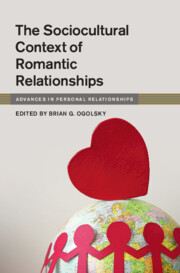Book contents
- The Sociocultural Context of Romantic Relationships
- Advances in Personal Relationships
- The Sociocultural Context of Romantic Relationships
- Copyright page
- Contents
- Contributors
- 1 The Sociocultural Context of Romantic Relationships
- 2 Systemic Racism and Romantic Relationships
- 3 Sociocultural Perspectives on Romantic Relationships
- 4 Gender and Heteronormativity in Romantic Relationships
- 5 Social Class, Neighborhoods, and Romantic Relationships
- 6 Religion and Spirituality in Romantic Relationships
- 7 The Importance of Work in Romantic Relationships
- 8 History and Cohort Effects in Romantic Relationships
- 9 The Legal Meaning of Sex (and Romantic Relationships)
- 10 Romantic Relationships and Traditional Media
- 11 Romantic Relationships and Social Media
- 12 Situating Latinx Immigrant Romantic Relationships in the Context of Illegality
- 13 Romantic Relationships during a Global Pandemic
- Index
- References
8 - History and Cohort Effects in Romantic Relationships
Published online by Cambridge University Press: 19 October 2023
- The Sociocultural Context of Romantic Relationships
- Advances in Personal Relationships
- The Sociocultural Context of Romantic Relationships
- Copyright page
- Contents
- Contributors
- 1 The Sociocultural Context of Romantic Relationships
- 2 Systemic Racism and Romantic Relationships
- 3 Sociocultural Perspectives on Romantic Relationships
- 4 Gender and Heteronormativity in Romantic Relationships
- 5 Social Class, Neighborhoods, and Romantic Relationships
- 6 Religion and Spirituality in Romantic Relationships
- 7 The Importance of Work in Romantic Relationships
- 8 History and Cohort Effects in Romantic Relationships
- 9 The Legal Meaning of Sex (and Romantic Relationships)
- 10 Romantic Relationships and Traditional Media
- 11 Romantic Relationships and Social Media
- 12 Situating Latinx Immigrant Romantic Relationships in the Context of Illegality
- 13 Romantic Relationships during a Global Pandemic
- Index
- References
Summary
Romantic relationships occur within a larger social, political, and historic context. Although family historians have attended to the changing social meaning and role of romantic partnering across historical time, few scholars have considered that the psychosocial meanings individuals attribute to historic events may shape romantic relationships dynamics. In this chapter, we consider how linkages between historic events and shifts in the socio-political environment of the United States may influence romantic relationships. We begin by reviewing the work of family historians before discussing theories and concepts relevant to examining romantic partnering within a historical context. We provide illustrative examples to highlight the overlap between cohort and historic effects across relationship initiation, maintenance, and dissolution. We conclude by reflecting on the conceptual and empirical challenges and possibilities associated with examining relationships from a historical perspective.
Keywords
- Type
- Chapter
- Information
- The Sociocultural Context of Romantic Relationships , pp. 135 - 150Publisher: Cambridge University PressPrint publication year: 2023



